Indesit IDCL 85 B H Instruction manual
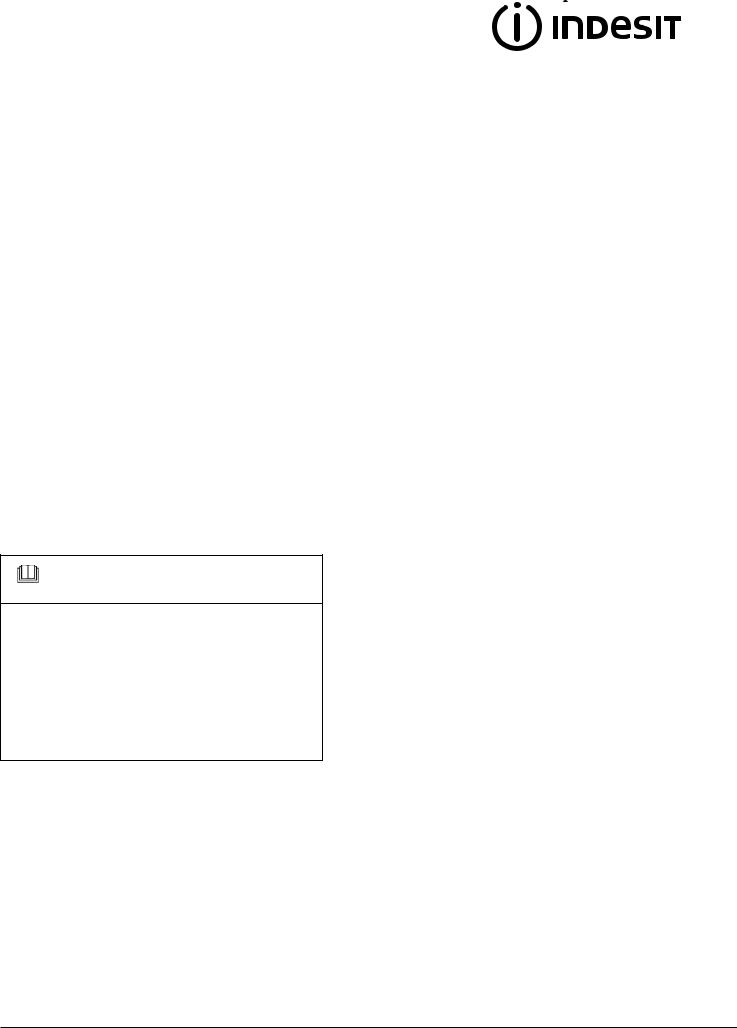
Instruction manual
|
|
|
|
|
|
|
|
|
|
TUMBLE DRYER |
Contents |
|
|||
|
GB |
||||||
|
|
|
|
|
|
Installation, 2 |
|
|
|
|
|
|
|
|
|
|
|
|
|
|
|
|
|
|
|
|
|
|
|
Where to install the tumble dryer |
|
|
|
|
|
|
|
Ventilation |
|
|
|
EN |
|
AR |
|
Electrical connections |
|
|
|
|
|
Preliminary information |
|||
|
|
|
|
|
|
|
|
|
|
English,1 |
،ةيبرعلا |
Warnings, 4 |
|||
General safety
Saving energy and respecting the environment
Care and maintenance, 6
Disconnecting the power supply
Cleaning the filter after each cycle
Checking the drum after each cycle
Emptying the water container after each cycle
Cleaning the condenser unit
Cleaning the tumble dryer
IDCL 85 B H
www.indesit.co.uk
!This symbol reminds you to read this instruction manual.
!Keep this manual at hand for immediate reference whenever
necessary. Always store this manual close to the tumble dryer and remember to pass it on to any new owners when selling or transferring the appliance, so they may familiarise with the warnings and suggestions herein contained.
! Read these instructions carefully: the following pages contain important information on installation and useful suggestions for operating the appliance.
Description of the tumble dryer, 8
Features Control panel
How to carry out a drying cycle, 10
Starting and selecting a programme
Programmes and options, 11
Programme chart Special programmes Options
Opening the door
Laundry, 14
Sorting laundry
Care labels
Drying times
Troubleshooting, 15
Assistance and Guarantee, 16
Spare parts
Information on recycling and disposal
1
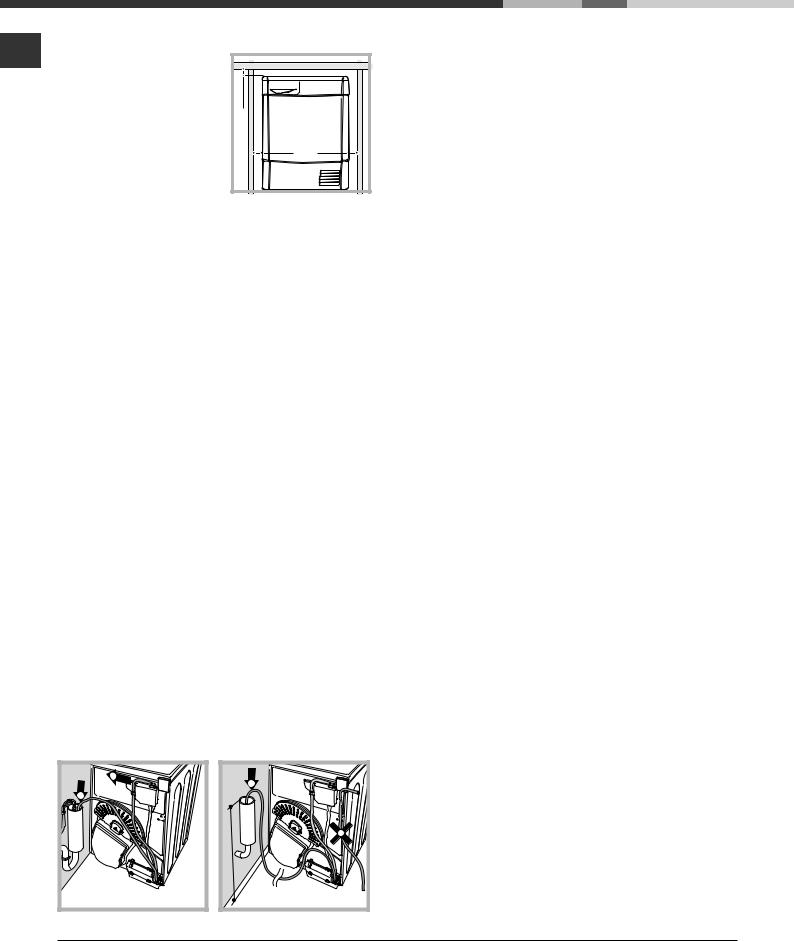
Installation
Where to install the tumble dryer
GB |
• Install the dryer far |
|
|
|
|
|
from gas ranges, stoves, |
mm |
|
radiators or hobs, as |
|
|
10 |
|
|
flames may damage it. |
|
|
|
|
|
If the dryer is installed |
|
|
below a worktop, en- |
15 mm 15 mm |
|
sure there are 10 mm |
|
|
between the upper pa- |
|
|
nel of the dryer and any |
|
|
objects above it, and 15 |
|
mm between the sides of the machine and the walls or furniture units adjacent to it. This ensures adequate air circulation.
The appliance must be installed with the rear surface placed against a wall.
Ventilation
• The room must be adequately ventilated while the dryer is running. Make sure that the dryer is installed in a room free of humidity and with adequate air circulation. The flow of air around the dryer is essential to allow water to condense during drying; the dryer will not function properly if it is placed in an enclosed space or inside a cabinet.
!Some condensation may form if the dryer is used in a small or cold room.
!We do not recommend that the dryer is
installed in a cupboard but the dryer must never be installed behind a lockable door, a sliding door or a door with a hinge on the opposite side to that of the dryer door.
Water drain
If your dryer is installed next to a drain the water can be plumbed into this drain. This does away with the need to empty the water container. If the dryer is stacked onto or installed next to a washing machine it can share the same drain. The height of the drain must be less than 3’ (1 m) from the bottom of the dryer.
Remove existing hose from position shown in picture A and fit a suitable length of hose and connect as shown in picture B.
! Make sure that the hose is not squashed or kinked when the dryer is in its final location.
1 |
2 |
Picture A
2 |
1 |
Less than 1m |
Picture B
Electrical connections
Before plugging the appliance into the socket, check the following:
•Make sure your hands are dry.
•The socket must have an earth connection.
•The socket must be able to withstand the machine’s maximum power output as indicated on the rating plate (see Description of the tumble dryer)
•The power supply voltage must fall within the values indicated on the data plate (see Description of the tumble dryer).
•The socket must be compatible with the dryer’s plug. Should this not be the case, replace the plug or the socket.
!DO NOT USE EXTENSION CORDS.
!The dryer must not be installed outdoors, even if the space is sheltered. It can be very dangerous if exposed to rain or storms.
!Once installed, the dryer’s electrical wire and plug must be within reach.
!The power cord must not be bent or squashed.
!If the plug being replaced is a non-rewirable type, then the cut-off plug must be disposed of safely. DO NOT leave it where it can be inserted into a socket and create a shock hazard.
!The power must be regularly checked. If the supply cord is damaged, it must be replaced by the manufacturer, its service agent or similarly qualified persons in order to avoid a hazard. (see Assistance). New or longer electric cords are supplied by authorised dealers at a supplementary cost.
!The manufacturer denies any responsibility should any of these rules not be followed.
!If in doubt about any of the above consult a qualified electrician.
Preliminary information
Once the tumble dryer is installed, clean the inside of the drum before operating it and remove any dirt accumulated during transportation.
2
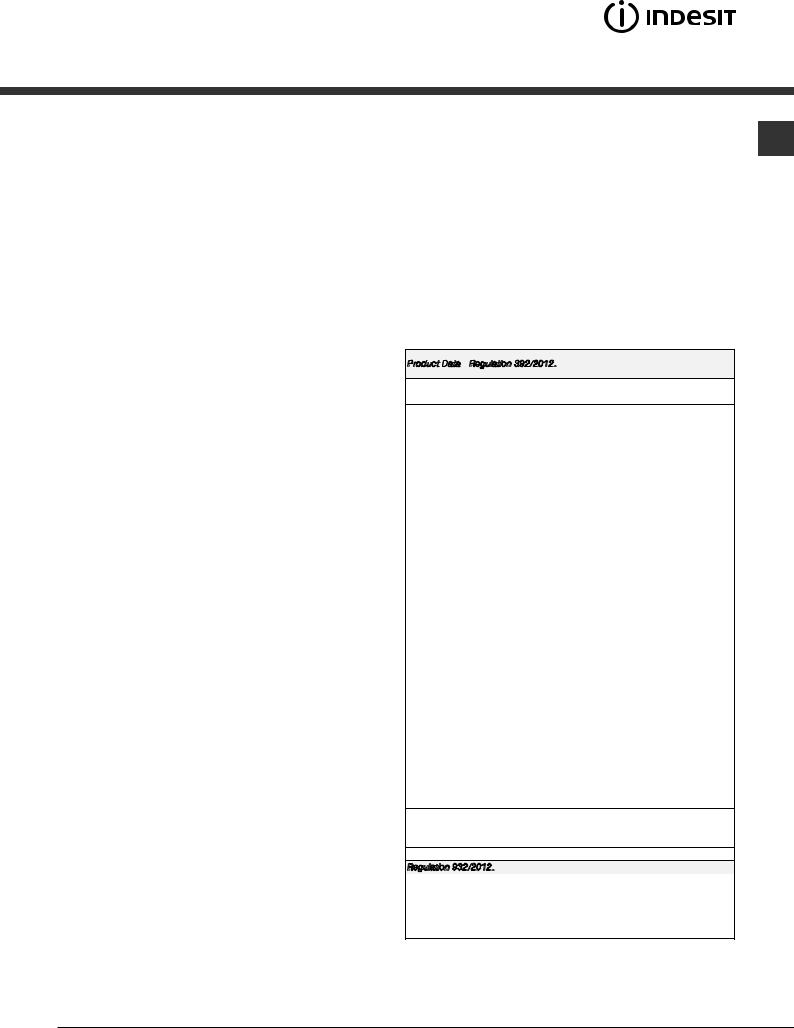
Maximum load sizes: 8 kg
GB
Product Data - Regulation 392/2012.
Brand
Indesit
Model
IDCL 85 B H (UK) IDCL 85 B HK (UK) IDCL 85 B HS (UK)
Rated capacity of cotton laundry for the "standard cotton |
8.0 |
|
programme" at full load - kg |
||
|
||
|
|
|
This household tumble drier is a |
Condenser |
|
Energy efficiency class on a scale from A+++ (low consumption) |
B |
|
to D (high consumption) |
||
|
||
|
|
|
The weighted Annual Energy Consumption (AEc)* kWh 1) |
560.6 |
|
This household tumble drier is a |
Automatic |
|
Energy consumption full load; Edry - kWh 2) |
4.75 |
|
Energy consumption partial load; Edry½ - kWh 2) |
2.52 |
|
Power consumption: off-mode (Po) - Watts |
0.42 |
|
Power consumption: left-on mode (Pl) - Watts |
2.24 |
|
Duration of the 'left-on mode' for power management system - |
30 |
|
minutes |
||
|
||
|
|
|
Prog. Time - weighted (Tt) full & partial load - minutes 3) |
100 |
|
Full load (Tdry) - minutes |
135 |
|
Partial load (Tdry½) - minutes |
73 |
|
Condensation efficiency class on a scale from G (least efficient) to |
B |
|
A (most efficient) |
||
|
||
|
|
|
Average condensation efficiency - % |
|
|
|
|
|
weighted (Ct) full & partial load 3) |
81 |
|
full load (Cdry) |
81 |
|
partial load (Cdry½) |
81 |
|
Airborne acoustical noise emissions - dB(A) re 1 pW |
68.0 |
1)The "standard cotton” at full and partial load are the standard programmes to which the information in the label and the fiche relates. The standard cotton program is suitable to dry at cupboard level (0%) cotton laundry and is the most efficient programme in terms of energy consumption. Partial load is half the rated load.
2)based on 160 drying cycles of the standard cotton programme at full and partial load, and the consumption of the low-power modes. Actual energy consumption will depend on how the appliance is used.
3)Weighted average of 3 cycles at full load and 4 cycles at half load.
Regulation 932/2012.
Energy consumption in kWh, for program “Synthetics” full load |
1.93 |
|
|
Programme time in minute, for program “Synthetics” full load |
85 |
|
|
Partial load for program “Synthetics” N/A |
|
|
|
3

Warnings
! This appliance has been designed and built GB according to international safety standards.
These warnings are given for safety reasons and must be followed carefully.
General safety
•This appliance can be used by children aged from 8 years and above and persons with reduced physical, sensory or mental capabilities or lack of experience and knowledge if they have been given
supervision or instruction concerning use of the appliance in a safe way and understand the hazards involved.
•This tumble dryer has been designed for home, and not professional, use.
•Do not touch the appliance while barefoot or with wet hands or feet.
•Unplug the machine by pulling on the plug, not the cord.
•After using the dryer, turn it off and unplug it. Keep the door closed to make sure that children do not use it as a toy.
•Children should be supervised to ensure that they do not play with the dryer.
•Cleaning and user maintenance shall not be made by children without supervision.
•Children of less than 3 years should be kept away from the appliance unless
continuously supervised.
•The appliance must be installed correctly and have proper ventilation. The air intake at the front of the dryer should never be obstructed (see Installation).
•Never use the dryer on carpeting where the pile height would prevent air from entering the dryer from the base.
•Check to see if the dryer is empty before loading it.
•The back of the dryer could become very hot.
Never touch it while in use.
•Do not use the dryer unless the filter, watercontainer and condenser are securely in place (see Maintenance).
•Do not overload the dryer (see Laundry for maximum loads).
•Do not load items that are dripping wet.
•Carefully check all instructions on clothing labels (see Laundry).
•Do not tumble dry large, very bulky items.
•Do not tumble dry acrylic fibres at high
temperatures.
•Do not turn off the dryer when there are still warm items inside.
•Clean the filter after each use (see Maintenance).
•Empty the water container after each use (see Maintenance).
●• Clean the condenser unit at regular intervals (see
Maintenance).
●• Do not allow lint to collect around the dryer.
•Never climb on top of the dryer. It could result in damage.
•Always follow electrical standards and requirements (see Installation).
•Always buy original spare parts and accessories (see Service).
To minimise the risk of fire in your tumble dryer, the following should be observed:
• Tumble dry items only if they have been washed with detergent and water, rinsed and been through the spin cycle. It is a fire hazard to dry items that HAVE NOT been washed with water.
●• Do not dry garments that have been treated with chemical products.
•Do not tumble dry items that have been spotted or soaked with vegetable or cooking oils, this constitutes a fire hazard. Oil-affected items can ignite
spontaneously,especially when exposed to heat sources such as a tumble dryer. The items become warm, causing an oxidisation reaction with the oil, Oxidisation creates heat. If the heat cannot escape, items can become hot enough to catch fire. Piling, stacking or storing oil-effected items can prevent heat from escaping and so create a fire hazard.If it is unavoidable that fabrics containing vegetable or cooking oil or those that have been contaminated with hair care products be placed in a tumble dryer they should first be washed with extra detergent - this will reduce, but not eliminate the hazard. They should not be removed from the dryer and piled or stacked while hot.
•Do not tumble dry items that have previously been cleaned in or washed in, soaked in or soiled with petrol/gasoline, dry cleaning solvents or other flammable or explosive substances. Highly flammable
4

substances commonly used in domestic
environments including cooking oil, GB acetone, denatured alcohol, kerosene,
spot removers, turpentine, waxes and wax removers. Ensure these items have been washed in hot water with an extra amount of detergent before being dried in the tumble dryer.
●• Do not tumble dry items containing foam rubber (also known as latex foam), or similarly textured rubber like materials. Foam rubber materials can, when heated, produce fire by spontaneous combustion.
●• Fabric softener or similar products should not be used in a tumble dryer to eliminate the effects of static electricity unless the practice is specifically recommended by the manufacturer of the fabric softener product.
•Do not tumble dry undergarments that contain metal reinforcements eg. bras with metal reinforcing wires. Damage to the tumble dryer can result if the metal reinforcements come loose during drying.
●• Do not tumble dry rubber, plastic articles such as shower caps or babies waterproof covers, polythene or paper.
•Do not tumble dry rubber backed articles, clothes fitted with foam rubber pads, pillows, galoshes and rubber coated tennis shoes.
•Remove all objects from pockets such as lighters and matches.
! WARNING: Never stop the dryer before the end of the drying cycle unless all items are quickly removed and spread out so that the heat is dissipated.
Save energy and respect the environment
•Wring out all items to eliminate excess water before tumble drying (if you use a washing machine first, select a high spin cycle). Doing this will save time and energy during drying.
•Always dry full loads - you save energy: single items or small loads take longer to dry.
•Clean the filter after each use to contain energy consumption costs (see Maintenance).
5
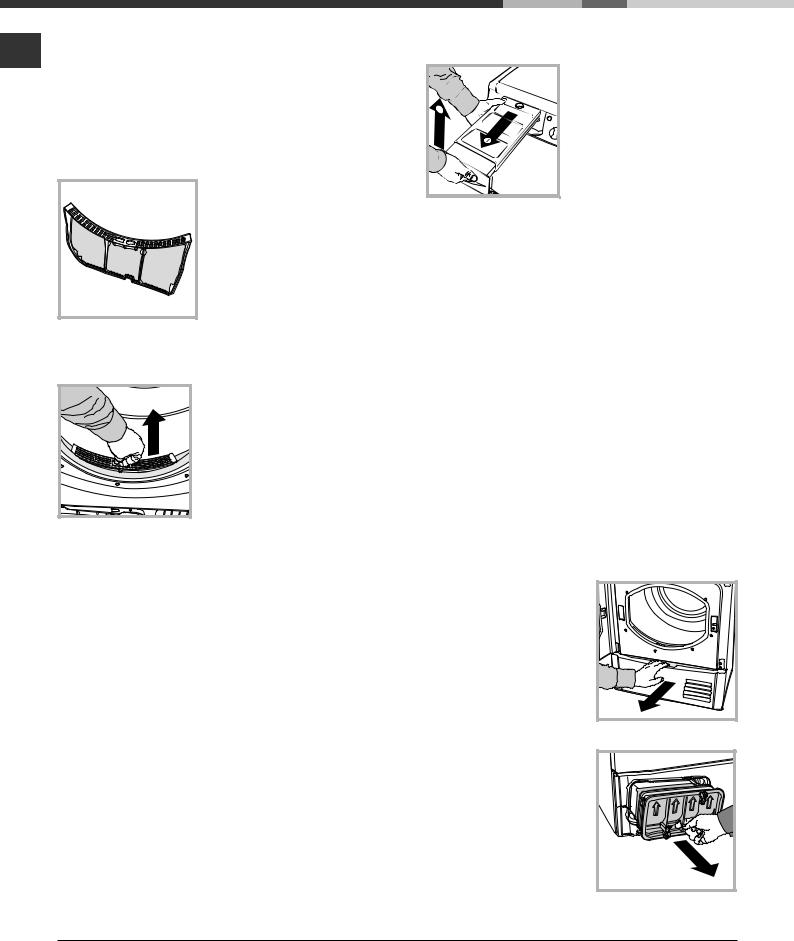
Care and maintenance
Disconnecting the power supply
GB ! Disconnect the dryer when not in use or during cleaning and maintenance operations.
Cleaning the filter after each cycle
The filter is a fundamental component of the dryer: its function is to collect lint and fluff that
form during drying. Clean the filter once drying is completed, by rinsing it under
running water or cleaning it with a vacuum cleaner. Should the filter become clogged, the flow of air inside the dryer will be
seriously hampered: drying times becomes loger and more energy is consumed. Moreover,
the dryer may become damaged.
The filter is located in front of the dryer seal
(see Picture).
Removing the filter:
1. Pull the filter’s plastic handle upwards (see
Picture).
2. Clean the fluff off the filter and replace it correctly. Ensure that the filter is pushed fully home.
! Do not use the dryer unless the filter has been replaced in its holder.
Checking the drum after each cycle
Rotate the drum manually to remove smaller items (handkerchiefs) that could have been left inside the dryer.
Cleaning the drum
! Avoid using abrasives, steel wool or stainless steel cleaning agents to clean the drum. A coloured film may appear on the stainless steel drum surface: it may be caused by a combination of water and/or cleaning agents such as wash-softeners. This coloured film does not affect the dryer’s performance.
Emptying the water container after each cycle
Remove the water container and empty it into a sink or other
suitable drain outlet, then
replace it correctly.
Always check the water container and empty it before starting
a new drying cycle.
-Failure to empty the water container may cause the following:
-The dryer stops heating (thus the load may still be damp at the end of the drying cycle).
-The “Empty water container” LED activates to
show that the water container is full.
Priming the Water Collection System
When your dryer is new, the Water Container will not collect Water until the system is primed, this will take 1 or 2 drying cycles. Once primed it will
collect Water during every cycle.
Cleaning the condenser unit.
• Remove the condenser (see Picture below) unit regularly (monthly) and clean off any fluff deposits from the plates by rinsing it with cold water running on the rear end of the condenser.
Removing the condenser:
1.Disconnect the dryer from the power
supply and open the door.
2.Open the
condenser cover (see Picture below), unlock the three catches by turning them 90° anti-clockwise, then pull on the grip to remove the condenser.
3. Clean the surface of the seals and replace the unit with the arrows pointing upwards, while making sure that the catches are securely fixed.
6
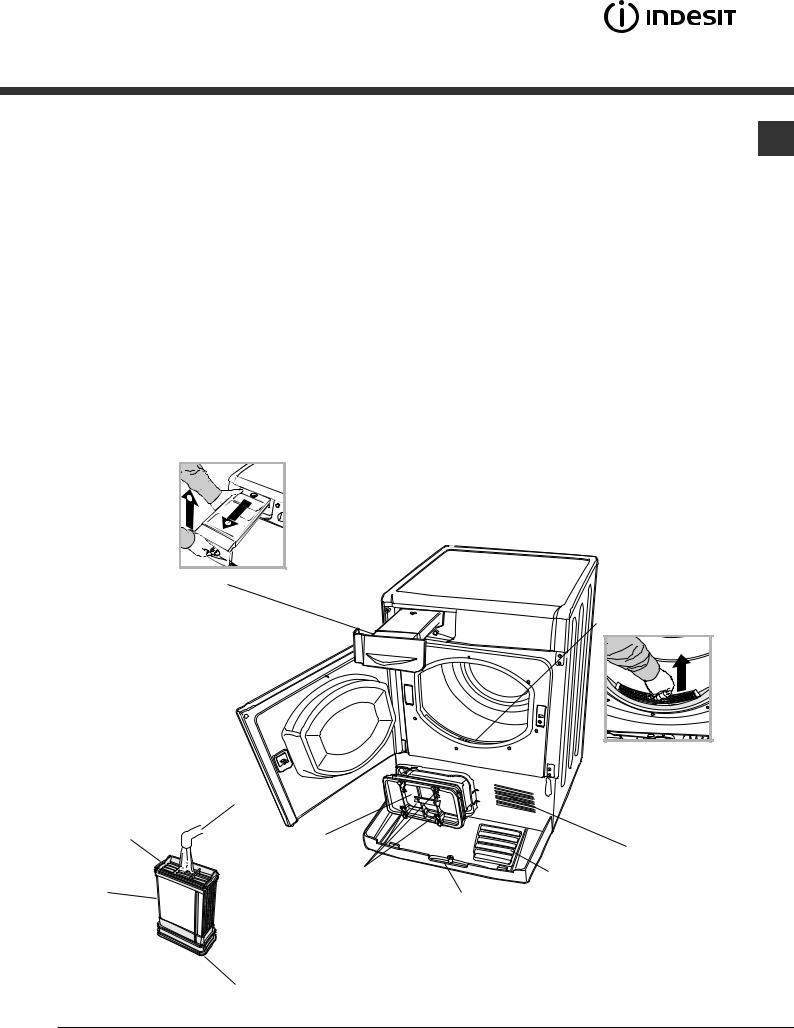
Cleaning the tumble dryer
•The external metal, plastic and rubber parts can be cleaned with a damp cloth.
•Clean the front air intake grille regularly (every 6 months) with a vacuum cleaner to remove any lint, fluff or dust deposits. Furthermore, remove any lint deposits from the front part of the condenser and from the filter area, using a
vacuum cleaner every so often.
!Do not use solvents or abrasives.
!Have the dryer checked regularly by authorised technical personnel in order to ensure that the electrical and mechanical parts work safely (see Assistance).
Quick Tips
!Remember to clean your filter and GB Condenser unit after each load.
!Remember to empty your water container after each load.
!Doing this will keep your machine
working at its BEST!
Water container
Filter
|
Tap |
|
Rear |
Condenser Unit |
|
|
|
|
|
|
Air intake |
Condenser unit |
Catches |
Condenser cover |
|
||
|
|
|
|
|
Handle |
Front
7
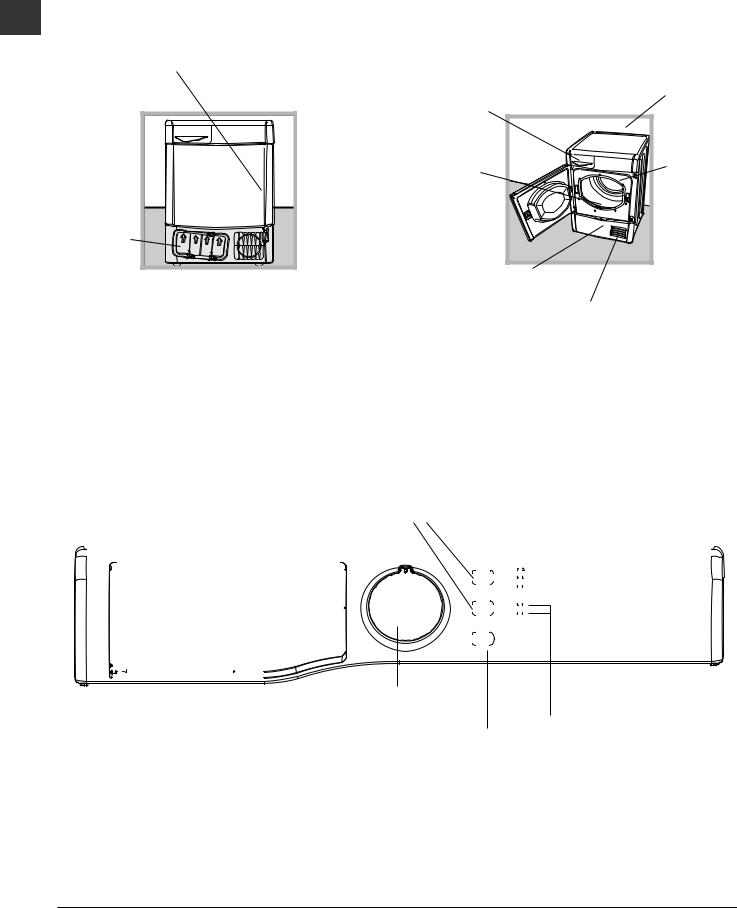
Description of the tumble dryer
|
|
|
|
|
Opening the door |
Features |
|||
GB
Press the
door
Water container |
Rating plate |
|
|
|
Model |
Filter |
& Serial |
|
Numbers |
Condenser unit (cover open)
Condenser cover handle (pull to
open) Air intake grille
Control panel
|
|
|
|
|
|
|
|
|
|
Options |
|
|
Drying phase |
|
|||||||
|
|
|
|
|
|
|
|
|
|
buttons and |
|
|
or Delay |
|
|||||||
|
|
|
|
|
|
|
|
|
|
indicator lights |
|
|
timer indicator |
|
|||||||
|
|
|
|
|
|
|
|
|
|
|
|
|
|
|
lights |
|
|
|
|||
|
|
|
|
|
|
|
|
|
|
|
|
|
|
|
|
||||||
|
|
|
|
|
|
|
|
|
|
|
|
|
|
|
|
|
|
|
|
|
|
|
|
|
|
|
|
|
|
|
|
|
|
|
|
|
|
|
|
|
|
|
|
|
|
|
|
|
|
|
|
|
|
|
|
|
|
|
|
|
|
|
|
|
|
|
|
|
|
|
|
|
|
|
|
|
|
|
|
|
|
|
|
|
|
|
|
|
|
|
|
|
|
|
|
|
|
|
|
|
|
|
|
|
|
|
|
|
|
|
|
|
|
|
|
|
|
|
|
|
|
|
|
|
|
|
|
|
|
|
|
|
|
|
|
|
|
|
|
|
|
|
|
|
|
|
|
|
|
|
|
|
|
|
|
|
|
|
|
|
|
|
|
|
|
|
|
|
|
|
|
|
|
|
|
|
|
|
|
|
|
|
|
|
|
|
|
|
|
|
|
|
|
|
|
|
|
|
|
|
|
|
|
|
|
|
|
|
|
|
|
|
|
|
|
|
|
|
|
|
|
|
|
|
|
|
|
|
|
|
|
|
|
|
|
|
|
|
|
|
|
|
|
|
|
|
|
|
|
|
|
|
|
|
|
|
|
|
|
|
|
|
|
|
|
|
|
|
|
|
|
|
|
|
|
|
|
|
|
|
|
|
|
|
|
|
|
|
|
|
|
|
|
|
|
|
|
|
|
|
|
|
|
|
|
|
|
|
|
|
|
|
|
|
|
|
|
|
|
|
|
|
|
|
|
|
|
|
|
|
|
|
|
|
|
|
|
|
|
|
|
|
|
|
|
|
|
|
|
|
|
Programme selection knob |
|
with OFF |
|
Start/Pause button |
Maintenance |
indicator lights |
|
and indicator light |
|
8

Programme selection knob
Allows for setting the programme: turn until the indicator points towards the desired programme. The OFF position switches off the GB dryer. (see Starting and selecting a programme).
Options buttons
Allow for selecting the options available for the selected programme. The relative indicator lights turn on when the option has been selected (see Programmes and options).
START/PAUSE button and indicator light
When the green light flashes slowly, press the button to start the programme. When the cycle is under way, the indicator light remains on. To put the programme into pause mode, press the button again; the indicator light will turn orange and start flashing again.
To resume the programme from the point it was interrupted, press the button again (see Start and programme selection).
Indicator lights
“Maintenance” indicator lights
The indicator lights provide important information. They indicate the following:
Before each programme, the indicators light  CLEAN FILTER and
CLEAN FILTER and  EMPTY WATER signals that it is essential to clean the filter and the water container must be emptied, before using the tumble dryer (see Care and maintenance).
EMPTY WATER signals that it is essential to clean the filter and the water container must be emptied, before using the tumble dryer (see Care and maintenance).
If the water container fills during the course of the programme, the LED lights up. The water container must be emptied before pressing the START/PAUSE button to resume the cycle from the point it was interrupted.
The “Clean condenser unit” indicator light  (CLEAN CONDENSER) signals that it is essential to clean the condenser regularly (see Care and maintenance).
(CLEAN CONDENSER) signals that it is essential to clean the condenser regularly (see Care and maintenance).
“Drying phases” indicator lights
The  DRYING indicator light signals that the drying phase is running.
DRYING indicator light signals that the drying phase is running.
The  COOL TUMBLE indicator light signals that the cooling phase is running. The END indicator light signals that the programme has ended.
COOL TUMBLE indicator light signals that the cooling phase is running. The END indicator light signals that the programme has ended.
“Delay timer” indicator light
If the ”Delay timer” option has been activated (see “Programmes and options”), after the programme has started, the indicator light corresponding to the chosen delay time will start flashing:
As time passes, the remaining delay will be displayed and the corresponding indicator light will flash:
Once the set delay time ends, the flashing LED will turn off and the set programme will start.
9

How to carry out a drying cycle
Starting and selecting a programme
GB
1.Plug the dryer into the power supply socket.
2.Sort your laundry according to fabric type (see Laundry).
3.Open the door, ensure that the filter is clean and securely placed and that the water container is empty and correctly slotted (see Care and maintenance).
4.Load the machine, making sure that no piece of laundry gets between the door and the relative seal. Close the door.
5.Turn on the dryer by moving the knob to a position other than OFF.
6.After consulting the programme chart and the indications for each type of fabric (see Laundry), turn the Programme selection knob towards the programme corresponding to the type of laundry to be dried (see Programmes and options).
! Warning: If the position of the programme selection knob changes after pressing the START/PAUSE button, the selected programme will NOT be modified. To modify the programme, press the START/PAUSE button to put the programme in pause mode (the indicator light flashes orange), then select a new programme and the relative options. Press the START/PAUSE button to start the new programme.
7.If necessary, set the time of the delayed start and any other options (see Programmes and options).
8.Press the START/PAUSE button to start the drying cycle.
Laundry can be checked while the drying programme runs and any garments already dry can be removed, while drying continues for the remaining items. After closing the door, press the START/PAUSE button to resume machine operation.
9.The final COOL TUMBLE phase (i.e. the fabrics are cooled) activates during the last few minutes of the drying programme; always allow this phase to terminate.
10.When the END indicator light turns on, the programme has ended. The buzzer will beep 3 times to let you know that your programme is complete. Open the door, remove the laundry then clean the filter and replace it. Empty the water container and put it back in its slot (see Care and maintenance).
If the clothes are not removed at the end of the cycle the automatic ANTI CREASE action will, on those programmes with this feature, continue to rotate the drum intermittently for up to 10 hours to minimise creasing. The phase is stopped when the door is opened or when the knob is set to OFF
11.Set the program knob to OFF to switch off the machine.
12.Disconnect the dryer from the power supply.
Automatic Anti Crease
This is an automatic function which provides an anti crease treatment both before and after the drying programme. By periodically rotating the drum before the start of the drying cycle, when a delayed start is selected, the formation of creases is prevented. On certain programmes the drum also rotates periodically at the end of the drying cycle on. The phase is stopped when the door is opened or when the knob is set to OFF
Stand-by mode
This tumble dryer, in compliance with new energy saving regulations, is fitted with an automatic standby system which is enabled after about 30 minutes if no activity is detected.
Turn the knob to the desired program to restart dryer operation (to start the program press START/PAUSE). The OFF position switches off the dryer.
10
